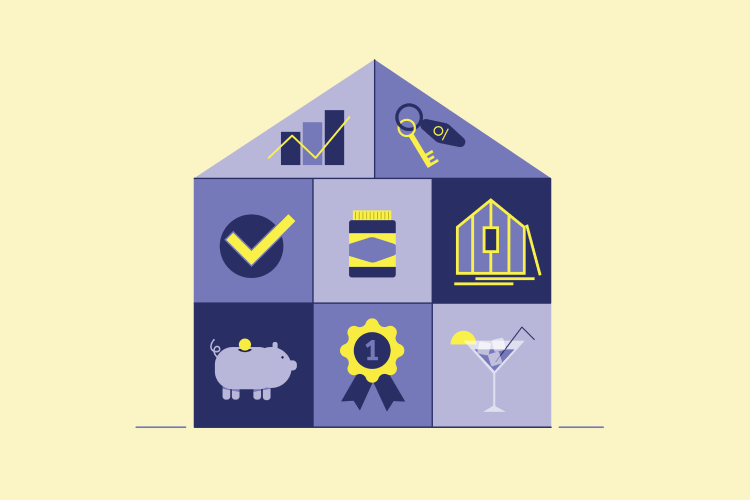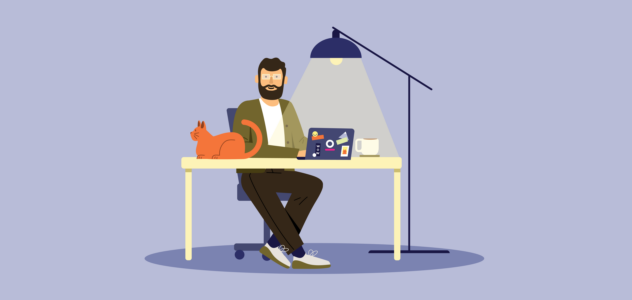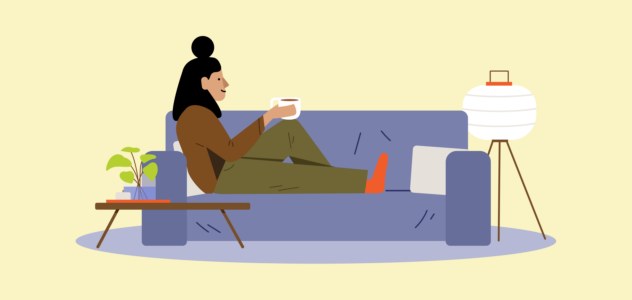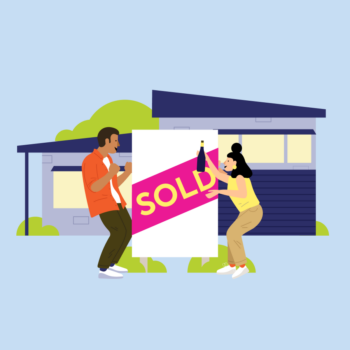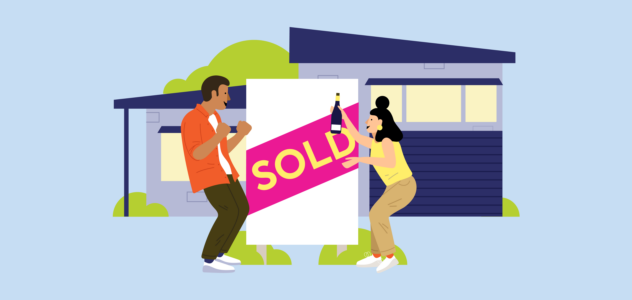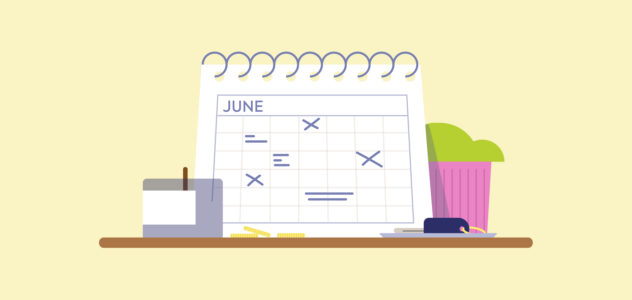Looking to buy your first home?
Well, you might be eligible for one of the many first home buyer grants and schemes available in Australia.
It’s essentially a chop out from the government – a way of them saying “hey, we know this home buying stuff is hard, here’s a helping hand.”
So let’s jump in. This is your ultimate guide to first home buyer grants, schemes and exemptions available in Australia, both at a federal level and in each state and territory.
So, what are the different types of first home buyer grants and schemes?
There are several different types of first home buyer grants and schemes, but they all serve a similar purpose: Saving! 👏You! 👏 Cash! 👏
These grants and schemes are either administered by the state government or the federal government.
Let’s take a closer look at both.
Federal programs
There’s one main federal program up for grabs: the First Home Buyer Guarantee Scheme (FHBG).
First Home Buyer Guarantee Scheme (FHBG)
The First Home Guarantee (FHBG) is part of the broader Home Guarantee Scheme (HGS). Under this scheme, eligible first home buyers can enter the property market with a deposit of less than 20% without having to pay Lenders Mortgage Insurance (LMI). In some cases, first home buyers can have a deposit as little as 5%. Booyah!
Note: LMI is the insurance a lender takes out (paid for by you, the borrower) to cover any risks in case the loan goes bad. And it’s more common when property buyers have a deposit of less than 20%.
To be eligible for the First Home Buyer Guarantee, buyers must be:
- Applying as an individual or two joint applicants
- An Australian citizen(s) or permanent resident(s) at the time they enter the loan
- At least 18 years of age
- Earning up to $125,000 for individuals or $200,000 for joint applicants, as shown on your Notice of Assessment issued by the ATO
- Intending to be owner-occupiers of the purchased property (that is, live in your new property)
- Either first home buyers OR previous homeowners who haven’t owned a property in Australia in the past ten years
There are also property price caps to be aware of – meaning you’re only eligible if your first home is under a certain price. Check out the caps for each state below.
| State | Capital City and Regional Centre* | Rest of State |
| NSW | $900,000 | $750,000 |
| VIC | $800,000 | $650,000 |
| QLD | $700,000 | $550,000 |
| WA | $600,000 | $450,000 |
| SA | $600,000 | $450,000 |
| TAS | $600,000 | $450,000 |
| ACT | NA | $750,000 |
| NT | NA | No limit |
*Regional centres include Newcastle and Lake Macquarie, Illawarra, Geelong, Gold Coast and Sunshine Coast.
Where to apply: You can apply for the FHBG through a participating lender (there’s more than 25 of them). Dreading the thought of more paperwork? No stress, speak to your mortgage broker who can manage all the admin for you (hey, that’s us!)
State based programs
There are three main state-based grants and schemes on offer: First Home Buyer Grants, Stamp Duty Waivers and Shared Equity Schemes.
Buuut there are slight differences in the way they play out depending on which state or territory you’re in. So, let’s first take a broad look at these programs, before diving into the specifics – state by state.
First Home Buyer Grants (FHOG)
Introduced on 1 July 2000, the First Home Owner Grant (FHOG) is a one-off payment to eligible first home buyers to help offset the effect of GST, with the funds typically received at the time of settlement. While it’s a national scheme, the states and territories administer it under their own legislation, so there are slight differences in how it plays out depending on where you live (more on this in the sections below).
Stamp Duty Waivers (AKA Transfer Duty)
Stamp duty or transfer duty is a tax that state or territory governments charge for certain transactions – usually on the ‘transfer of land’. It’s typically around 5% of the purchase price. The good news? The stamp duty waiver exempts or provides a discount for first home buyers paying this tax.
Shared Equity Schemes
A shared equity scheme is when an additional party acts as both the lender and investor (usually the government). In most cases, the government makes a financial contribution to the purchase of your property, and in return takes a share in the property (although the way these schemes play out can vary across each state).
These are typically only available for low to moderate income households or to those working in specific essential services.

First home buyer grants and schemes – state by state
Scroll down to the state or territory where you plan to purchase your home to learn more.
Victoria
First Home Buyer Grant Victoria
In Victoria, the First Home Owner Grant (FHOG) is $10,000 when you buy or build your first new home.
Take note of the word new – a new home can be a home that has been substantially renovated, or a home built to replace a demolished house.
The beauty of a first home owners grant is that unlike a loan or debt, you don’t have to pay it back. Free money, if you will.
But you still have to jump through the right hoops and satisfy all the eligibility criteria.
To apply, you must:
- Be a natural person (no, not wholesome – natural in this context means not applying as a company or trust)
- Be at least 18 years of age at the date of settlement or completion of construction
- Be buying or building a home where the contract price of the property does not exceed $750,000
- Be an Australian citizen or a permanent resident* at the date of settlement or completion of construction (at least one applicant, anyway)
- Lodge an application with your approved lender (bank or credit union) or to the State Revenue Office (SRO) after settlement and within 12 months of buying your property
- Be buying or building a home where the contract was signed on or after 1 July 2000, or building a home as an owner builder where building started on or after 1 July 2000
- Make sure that everyone holding a ‘relevant interest’ (AKA a legal entitlement) in the property is an applicant
- Live in the home, or to be more specific, at least one applicant will live in the home as their principal place of residence for a continuous period of at least 12 months, starting within 12 months of the transaction
- Include your partner/spouse details on the application, and provide their supporting documentation
*Because we Aussies love New Zealanders – New Zealanders holding a special category visa under s32 of the Migration Act 1958 and anyone holding a permanent visa under s30(1) are considered permanent residents for these purposes. New Zealand citizens must be living in Australia when the eligible transaction is completed.
Applicants and their spouse/partner must not:
- Have previously received a First Home Owner Grant in any other state or territory of Australia
- Have previously owned a residential property anywhere in Australia, before 1 July 2000
- Have occupied, for a continuous period of at least six months, a residential property which either of you owned or part-owned on or after 1 July 2000 anywhere in Australia
Where to apply: You can lodge your application with an approved finance agent or the State Revenue Office. Sounds complicated? You can also ask for a helping hand from your mortgage broker (that’s us!)
For more details, check out the State Revenue Office Lodgement Guide.
Stamp Duty Waiver Victoria
In Victoria, it’s called the first home buyer duty exemption or concession (exemption meaning you pay zero stamp duty, and concession meaning you score a discount on stamp duty).
If you entered into a contract to buy your first home before 1 July 2017, you may be eligible.
The best bit? This is available in addition to the First Home Owner Grant (so eligible and savvy home buyers could score both). And unlike the First Home Owner Grant (FHOG) it doesn’t matter whether the house is new or established – woo!
Eligibility requirements:
The first home buyer duty exemption or concession may be available if your home has a ‘dutiable’ value (the price of the property including GST, usually the contract price) of:
- $600,000 or less to get the first home buyer duty exemption
- $600,001 to $750,000 to get the first home buyer duty concession
In addition, all the purchases of the property must meet the First Home Owner Grant eligibility criteria (see above) and one purchaser must be an Australian citizen or resident.
To apply, you must complete a digital duties form on the State Revenue Office Website.
Learn more about applying for a first home buyer duty exemption, concession or reduction.
Shared Equity Scheme Victoria
It’s called the ‘Victorian Homebuyer Fund’ in Victoria and it’s a great incentive to support low to middle income Victorians into homeownership.
Simply, if you have a 5% deposit, the Victoria Government can contribute up to 25% of the purchase price. In return, they’ll get a share in the property (so you’re kinda sharing your property with the government for a little while). This saves you cash by a) reducing your mortgage, and b) helping you side-step Lenders Mortgage Insurance.
But a few ‘good to knows’ – to get the Victorian Homebuyer Fund the property must be a standard residential property like a house, townhouse or apartment (not vacant land). The maximum purchase price is $950,000 or less in Metropolitan Melbourne and Geelong, or $600,000 or less in regional Victoria.
Eligibility requirements:
To get the Victorian Homebuyer Fund, you need to:
- Be an Australian or New Zealand citizen, or permanent Australian resident
- Be at least 18 years of age at settlement
- Have saved the required minimum deposit of the property price (at least 5% or 3.5% for Aboriginal and Torres Strait Islander participants)
- Have a gross annual income of $130,485 or less for individuals or $208,775 or less for joint applicants
- Move into the purchased property – AKA make it your ‘principal place of residence’
- Be a natural person (no, not wholesome, in this context it means not an organisation, company, trust or other body or entity)
- Not purchase the property from family – in other words, a vendor you’re related to
- Not own an interest in any land in Australia or overseas at the time of purchase (including as trustee of a trust or beneficiary under a trust)
- Not be a shareholder in any corporation (other than a public company) that owns any land in Australia or overseas
- Have an approved loan from a participating lender and have sufficient funds to pay all other costs associated with the purchase
Where to apply: If you’re eligible, you can start by putting together the required documentation and go through a participating lender (this is a must for getting the Homebuyer Fund).
Learn more about applying for the Homebuyer Fund.
New South Wales
First Home Buyer Grant NSW
In New South Wales, the First Home Owner Grant (FHOG) is also called the ‘New Home’ Grant. And as the name suggests, it’s $10,000 that goes towards the purchase price of your NEW home. Cha-ching.
Take note, a new home is a home that no one has lived in before – either brand new or substantially renovated.
And the beauty of a first home owners grant? Unlike a loan or debt, you don’t have to pay it back and you don’t have to pay tax on it.
But you still have to satisfy all the eligibility criteria.
To apply, you must:
- Stick to the property requirements:
- A maximum price of $600,000 for a newly built house, townhouse, unit or apartment, OR
- A maximum price of $750,000 for vacant land and a comprehensive building contract
- Be over 18 (this can be waived in some circumstances by Revenue NSW)
- Must be an individual (AKA not a company or trust) – this can also be waived in specific circumstances
- Must not have received the grant before (ahem, no double dipping)
- Must not have previously owned a home, before 1 July 2000 (if you DID purchase a property after this date but you didn’t live in it for more than six continuous months, you might still be eligible
- Be an Australian citizen or permanent resident (or at least one of you in a joint application)
- You must occupy the home as your principal place of residence – a fancy way of saying you’ll need to live in the property within 12 months of buying it, and live in it continuously for at least 12 months*
*Members of the Australian Defence Force are exempt from the residence requirement, provided they’re enrolled to vote in NSW.
Learn more about the First Home Buyer Grant NSW.
Where to apply: you can apply for the NSW First Home Owner (New Home) Grant through your bank or lender when you’re organising your loan. A mortgage broker can help you through this process (phew).
Transfer Duty Waiver NSW
In New South Wales, this is called the ‘First Home Buyers Assistance Scheme’ (FHBAS).
Eligible first home buyers can either receive a transfer duty (tax) exemption OR a reduced rate when they’re buying a new or existing home or vacant land to build a home. Here’s what we mean:
- Eligible first home buyers purchasing an existing property for $800,000 or less won’t pay any transfer duty at all – booyah
- Eligible first home buyers purchasing a property between $800,000 and $1 million will pay a reduced rate
- If you buy vacant land to build a house on, there will be no transfer duty if it’s $350,000 or less, or a reduced rate if it’s between $350,000 and $450,000
To apply, you must:
- Purchase a property with a maximum price of $1 million
- Be 18 years or over (this can be waived in some circumstances by Revenue NSW)
- Be an Australian citizen or permanent resident (or at least one of you in a joint application)
- Be an individual (AKA not a company or trust) – this can also be waived in specific circumstances
- Not have owned or co-owned residential property in Australia (this applies to both applicants in a couple)
- Not have previously received an exemption or concession (this applies to both applicants in a couple)
- If you’re buying with friends or family (not a spouse) the eligible first home buyer must purchase at least half of the property, and the ineligible buyer must pay transfer duty on their share
- If you’re buying an existing home, you’ll need to live in the property within 12 months of buying it, and live in it continuously for at least 12 months*
- If you’re buying land, you’ll need to intend to build a new home and move into the property within 12 months of the completed build, and live in it continuously for at least 12 months*
*Members of the Australian Defence Force are exempt from the residence requirement, provided they’re enrolled to vote in NSW
Learn more about the First Home Buyers Assistance Scheme.
Where to apply: Your conveyancer or solicitor is the go-to for this application.
Shared Equity Scheme NSW
Known as the ‘Shared Equity Home Buyer Helper’ in New South Wales, this scheme is aimed at helping key workers, single parents, older singles, and victim-survivors of domestic and family violence. If you’re eligible, you may be able to purchase a home with a deposit as low as 2%.
So, how does it work? The NSW Government can contribute up to 40% of the purchase price for a brand new home or 30% for an existing dwelling. This helps to reduce the deposit required.
While the government will own a ‘share’ in the property, it’s important to remember the mortgage and home are yours (it’s just a helping hand to get there). You don’t HAVE to make repayments towards the government’s share, but if you have the capacity, you can choose to make voluntary payments down the track so you own a greater share of the property.
To be eligible for the shared equity program, you must:
- Contribute a minimum of 2% of the purchase price towards the deposit
- Be able to service the mortgage (after the government contribution)
- Not be able to get approved for a mortgage without the government contribution
- Live in the property you purchase
- Not own any other land or property
- Be 18 years of age or over
- Be an Australian or New Zealand citizen (or permanent Australian resident)
- Fall into one of the following groups:
- Single parents with a dependent child or children
- Older singles aged 50 years or above
- First home buyer key workers, employed as early childhood educators, teachers, nurses, midwives, paramedics or police officers
- Victim-survivors who have experienced a domestic and family violence incident within the last 5 years
- Purchase a home at a maximum price of $950,000 for homes in major centres and $600,000 for homes in regional areas
- Be able to cover the home purchasing costs, like conveyancing, building and pest inspections and more
- Have a gross annual income of $93,200 or less for individuals or $124,200 or less for couples (asset limits also apply)
Learn more about the Shared Equity Home Buyer Helper.
Where to apply: You can apply through eligible lending partners. At the moment in NSW, this includes Bendigo Bank and Unity Bank.

Queensland
First Home Buyer Grant QLD
If you live in Queensland, you might be in luck.
The First Home Owner Grant gives eligible first home buyers $15,000 or $30,000 towards buying or building a new home (and by new, we mean a brand new dwelling that hasn’t been previously lived in).
More specifically, the grant amount is:
- $30,000 for contracts signed between 20 November 2023 and 30 June 2025 (both dates inclusive)*
- $15,000 for contracts signed before 20 November 2023*
*The same amounts apply for owner-builders, only the foundations need to have been laid (rather than contracts signed) within the above dates.
But to get this ‘free money’ (our words, not the governments) you need to satisfy all the eligibility criteria.
To apply, you must:
- Be 18 years or over (this can be waived in some exceptional circumstances by the Commissioner of State Revenue)
- Be buying or building a new home valued less than $750,000 (including land and any contract variations)
- Be a natural person (no, not wholesome – this means you must be an individual, not a company or trust)
- Be an Australian citizen or permanent resident (or at least one of you in a joint application)
- Not have received a previous First Home Owner Grant in any other state or territory in Australia (this applies to both applicants in a joint application) however, if you’ve received a grant that you later paid back, you may be eligible to reapply
- Not have owned a property in Australia (on or after 1 July 2000 that you lived in, before 1 July 2000 whether you lived in it or not)
- Not be purchasing an investment property (if you’ve owned an investment property since 1 July 2000, you may still be eligible for the FHOG provided this is your first home you plan to live in – you’ll need to provide proof though)
- Occupy the home as your principal place of residence – a fancy way of saying you’ll need to live in the property within 12 months of buying it, and live in it continuously for at least 6 months
In Queensland, some factors may ‘disqualify’ you from getting the FHOG, including:
- No longer meeting the requirements or eligibility for receiving the grant
- Applying for the grant for the sole purpose of getting the grant, rather than owning a home
- Buying or building your new home with financial help (from someone who was not eligible for the grant)
Learn more about the Queensland First Home Owner Grant.
Where to apply: You can apply through an approved agent (AKA your lender) or through the Queensland Revenue Office. Sound confusing? Our mortgage brokers have got you.
Regional Home Building Boost Grant QLD
As the name suggests, the Regional Home Building Boost Grant is all about helping home owners in regional Queensland move into their new homes, sooner.
It’s a $5000 grant for eligible applicants, received after the purchase or building of a brand-new house (this could be a property, unit or townhouse that has not been lived in).
Intrigued? Read on.
To apply:
- If you have a contract to buy or build, it must be dated between 4 June 2020 and 31 March 2021
- If you’re an owner-builder who’s building a new home, your build must have started from 4 June 2020 and 31 March 2021
- Be at least 18 years of age
- Be an Australian citizen or permanent resident (or applying with someone who is)
- Not have received a previous regional home building boost grant
- Be buying or building a brand new home (that is, a home that’s never been lived in)
- Be buying a home (including the land) at a value less than $750,000
- Must be moving into the new home as your principal place of residence – a fancy way of saying you’ll need to live in the property within 12 months of buying it, and live in it continuously for at least 6 months
- Be buying a home in regional Queensland (check your postcode)
- Be entering an eligible transaction – that is:
- A contract to buy a new home, including a substantially renovated home
- A contract to build a new home
- Building a new home as an owner-builder
Learn more about the Queensland Regional Home Building Boost grant
Where to apply: you can apply online to obtain the grant. You’ll need to confirm your eligibility and whether you’re buying, building, or building as an owner-builder.
Transfer Duty Waiver QLD
The ‘First Home Concession’ is Queensland’s version of the transfer duty waiver – a savvy way to get a solid discount on transfer duty (AKA tax) when buying your first home.
The First Home Concession only applies to homes less than $550,000, and unlike many other states and territories, you don’t have to be an Australian citizen or permanent resident. But you DO have to jump through some other hoops.
To apply, you must:
- Be buying the property as an individual (not a company or trust, unless in specific circumstances)
- Never have claimed the ‘first home vacant land concession’
- Never have held an interest in another property, anywhere in Australia or overseas
- At least 18 years of age (may be waived in exceptional circumstances)
- Move into the home within one year of settlement
- Not sell, transfer or lease out the property before you move in
- Buy a property valued between $500,001 and $549,999
- While you don’t have to be an Australian citizen or permanent resident, if you’re from overseas, additional foreigner acquirer duty may apply (an extra 7% of duty)
- Not demolish the existing home without first living there
The first home concession amount varies depending on the home value and duty payable, but you could save up to $15,925 (did someone say Euro summer?)
Learn more about Queensland’s first home concession.
Where to apply: You can complete a series of forms online and lodge them at the same time as your contract and property valuation.
Shared Equity Scheme QLD
Known as the ‘Pathways Shared Equity Loan’ in Queensland, this scheme aims to help tenants in government-owned housing own a share of their home (or eventually, become a full home owner).
Unlike similar arrangements in other states and territories, in Queensland, the home must be:
- The one you’re currently renting
- Available for purchase
To be eligible, you must:
- Already be a public housing tenant (renting the home you want to own a share of)
- Be an Australian citizen or permanent resident
- Not own or part-own another property
- Unable to afford to buy 100% of the home (via a standard home loan)
- Show proof of a good credit history and no other significant debts
- Be able to afford the repayments (these will be no more than 35% of your income)
- Live in the home for the duration of the shared equity agreement
- Not already have an outstanding government debt
- Take responsibility for additional fees, like council rates, maintenance costs and home insurance
Sound like you might tick the boxes? Learn more about the pathways shared equity loan in Queensland.
Where to apply: The Queensland government website states the first step is to get in touch, either via phone or email. Phone: 1300 654 322. Email: loaninformation@chde.qld.gov.au
Western Australia
First Home Buyer Grant WA
In WA, the First Home Buyer Grant gives eligible first home buyers $10,000 towards buying or building a new home (and by new, we mean a brand new dwelling that hasn’t been previously lived in).
The best bit? There are no income or assets tests to qualify. But there are capped amounts for the home you choose to buy, which depend on the location. In WA, we talk in terms of lines of latitude (fancy).
- South of the 26th parallel of South latitude, the value of the land and building must not exceed $750,000 (this includes all Perth metropolitan areas).
- North of the 26th parallel of South latitude, the value of the land and building must not exceed $1,000,000.
To apply, you must:
- Be 18 years or over (the eager under 18 year olds can apply for an exemption)
- Be an Australian citizen or permanent resident (at least one applicant, anyway)
- Hold a relevant interest in the land where the home is situated (and by interest, we mean ownership, not intrigue)
To get the FHOG in WA, you or your spouse/defacto must not:
- Have previously received the grant (from any state or territory in Australia)
- Owned a residential property anywhere in Australia before 1st July 2000
- Owned residential property anywhere in Australia on or after 1st July 2000 and lived in that property before 1st July 2004
- Owner residential property anywhere in Australia on or after 1st July 2000 and lived in that property for a continuous period of at least six months (beginning on or after 1st July 2004).
Where to apply: Complete the application form found on the FHOG Lodgement Guide.
Learn more about WA’s first home concession.
Transfer Duty Waiver WA
The ‘First Home Owner Rate’ is WA’s version of the transfer duty waiver. Although in WA, it’s not so much a waiver, but a discount.
It applies a ‘concessional’ rate of duty to certain transactions – like buying a home or land.
Eligibility requirements:
The First Home Owner Rate has thresholds and limits to the price of your home or land, also referred to as the ‘dutiable’ value (the price of the property including GST, usually the contract price).
- Home and land: The unencumbered value of the home and land together must not exceed $530,000.
- Vacant land: The unencumbered value of the vacant land must not exceed $400,000.
In addition, eligibility for the First Home Owner Rate is the same as the First Home Owner Grant (see above). Therefore, if you qualify for the First Home Owner Grant, you’ll likely qualify for this incentive, too. Booyah!
You can also qualify for the First Home Owner Rate if you would have qualified for the First Home Owner Grant, except that:
- Your transaction was for the purchase of an established home
- No consideration was paid under the transaction
- You’re an Indian Ocean Territory resident acquiring your first home
Where to apply: complete the application form found on the WA Government website.
Learn more about WA’s First Home Owner Rate.
Shared Equity Scheme WA
Known as the ‘Shared Home Ownership Arrangement’ in WA, this incentive offers a range of affordable housing and land options. It’s aimed especially at those with Aboriginal or Torres Strait Islander descent, sole parents wanting to keep their family home after a relationship breakdown or death of a partner, or those currently living in public housing who wish to buy the house they’re living in.
So, how does it work? Western Australia’s Housing Authority will fund up to a maximum of 30% of the purchase of your home. They’ll then ‘co-own’ a share of your property (but the home is still yours, they’re more like a silent partner).
Eligibility requirements:
This initiative is aimed at:
- Singles earning up to $70,000 per year
- Couples and families with a combined annual income of up to $90,000
To learn more about the eligibility requirements, or to find out if you’re eligible, visit the opening doors website or apply through Keystart.
Northern Territory
First Home Buyer Grant NT
In the Northern Territory, the First Home Buyer Grant is $10,000 for buying or building a new home (in this case, new means a brand new dwelling that hasn’t been previously lived in).
To apply, you must:
- Be at least 18 years of age or older (at least one applicant)
- Be a permanent resident or Australian citizen (at least one applicant)
- Have never received a grant under the First Home Owner Grant Act in any state or territory in Australia (this applies to both applicants)
- Never held a relevant interest in a residential property, either jointly, separately, or with another person, before 1 July 2000 (in any state or territory of Australia)
- Be a natural person (no, not wholesome – we mean not a company or trust)
- Be planning to occupy the home as your principal place of residence for a continuous period of 6 months, starting within 12 months of the transaction
Where to apply: check your eligibility and then fill in the application form found in the First Home Buyer Grant guide.
Learn more about Northern Territory’s First Home Owner Grant.
Tasmania
First Home Buyer Grant TAS
Tasmania is known for its clean fresh air. But perhaps it should also be known for its generous First Home Owner Grant!
In Tassie, a First Home Owner Grant is available to eligible applicants who purchase or build a new home from 1 July 2016 (new means it hasn’t previously been occupied or sold, including kit homes). The grant is a whopping:
- $30,000 for transactions commencing between 1st April 2021 and 30 June 2024
- $20,000 for transactions commencing between 1 July 2016 and 31 March 2021
To apply, you must:
- Be a natural person (not a company)
- Be 18 years old or over
- Be an Australian citizen or permanent resident (at least one applicant)
- Occupy the home as your principal place of residence for a continuous period of at least 6 months, commencing within 12 months of the transactions
Applicants (or their spouses) must not have:
- Owned a residential property in Australia before 1 July 2000
- Owned and occupied a residential property for more than 6 months in Australia after 1 July 2000
- Received the First Home Owner Grant before
Where to apply: gather your supporting documentation and complete your First Home Owner Grant application via the Tasmania Government website.
Learn more about the First Home Owner Grant.
Transfer Duty Waiver TAS
In Tasmania, it’s called the ‘First Home Buyers of Established Homes Duty Concession.’
While it sounds like a mouthful, it essentially provides a 50% discount on property transfer duty for first home buyers of an established home (so it’s worth knowing about).
The home must be:
- $400 000 or less for property purchases between 7 February 2018 and 15 March 2021 (inclusive)
- $500 000 or less for property purchases between 16 March 2021 and 31 December 2021 (inclusive)
- $600 000 or less for property purchases between 1 January 2022 and 30 June 2024 (inclusive)
To apply, you must:
- Be purchasing a home that doesn’t exceed the above limits
- Be a natural person (not a company or a trust)
- Be at least 18 years of age
- Be an Australian citizen or permanent resident (at least one applicant)
- Occupy the home as your principal place of residence for a continuous period of at least 6 months, commencing within 12 months of the transactions
- Must not have previously owned a home in Australia (or have a spouse or partner who has owned a home)
- Must not have received a First Home Owner Grant in any state or territory of Australia OR the Duty Concession (or have a spouse or partner who has)
- Submit the application form with the correct documents
- Make sure each person holding a relevant interest (AKA share) in the property is listed on the application
Where to apply: you can apply via mail or submit an electronic application. Visit the Tasmanian Government Website for more information.
Learn more about the First Home Buyers of Established Homes Duty Concession.
Shared Equity Scheme TAS
It’s known as the MyHome Shared Equity Program in Tasmania, and it’s targeted toward those who are feeling stretched to pay rent and save for a deposit.
So, how does it work? Homes Tasmania makes an equity contribution (the contribution amount depends on what type of home you purchase) so you can buy a home with a deposit of as little as 2%. The main way the My Home Shared Equity program differs from other states is that you have to pay Homes Tasmania’s share back before 30 years.
So, how much is the assistance? It’s:
- Up to a maximum of $200 000 or 40 per cent (whichever is the lesser amount) of the purchase price for purchasers of new homes or house and land packages
- Up to a maximum of $150 000 or 30 per cent (whichever is the lesser amount) of the purchase price for purchasers of existing homes.
If you’re buying a home that’s been lived in, there’s a property price cap of $600,000.
To be eligible, you must:
- Have an income to meet the cost of purchasing and owning a home
- Have financial assets that equal no more than $113 100 (if you qualify for the First Home Owners Grant, or you are purchasing an existing home and qualify for the First Home Buyer Stamp Duty Concession, or you are a tenant in a Homes Tasmania property, you are exempt from this requirement)
- Live in Tasmania
- Be an Australian citizen or permanent resident
- Be at least 18 years old
- Be an individual (not a business or organisation)
- Have a minimum deposit of 2% of the purchase price
- Not own or have an interest in any other property (however, you can own land that you want to build your home on with the assistance of MyHome)
- Not be an undischarged bankrupt or discharged from bankruptcy within three years before applying
- Not owe any money to Homes Tasmania
- Not have previously received help under HomeShare, Streets Ahead or Home Ownership Assistance Program (HOAP)
- Be able to pay legal and establishment fees
- Live in the house you buy
Where to apply: you can apply via mail or submit an electronic application. Visit the Tasmanian Government Website for more information.
Learn more about the MyHome Share Equity Program.

South Australia
First Home Buyer Grant SA
South Australia’s generous First Home Owner Grant of $15,000 (booyah) is up for grabs if you’re buying or building a new home that’ll be your principal place of residence (AKA where you live).
Take note, a new home is a house, flat, unit, townhouse or apartment that hasn’t been previously lived in (this can include a substantially renovated home).
But you’ve got to tick a few boxes to get the grant.
To apply, you must:
- Be purchasing a new home
- Be purchasing a property with a market value of $650,000 or less (contracts on or after 15 June 2023) or $575,000 or less (contracts between 17 September 2010 and 14 June 2023)
- Be an Australian citizen or permanent resident (at least one applicant). New Zealand citizens permanently residing in Australia who hold Special Category Visas can also apply
- Be 18 years of age or older
- Have not held a relevant interest in an Australian residential property before 1 July 2000
- Not occupied an Australian residential property in which you had a relevant interest on or after 1 July 2000 for 6 months or longer
- Have not previously received a first home owner grant in any state or territory of Australia (you may still be eligible if you received a grant and paid it back)
- All applicants must reside in the home for a continuous period of at least 6 months, starting within 12 months of when you settle or construction is complete
- Not be a company or trust
Where to apply: In most cases, the bank that’s providing your finance will lodge your First Home Owner Grant application for you – or you can lodge it yourself with an approved agent. Learn more about applying here.
Learn more about the First Home Owner Grant.
Transfer Duty Waiver SA
Known as the ‘Stamp Duty First Home Buyer Relief’ in South Australia – this incentive can either waive or partially reduce your stamp duty.
So what’s the deal? The Stamp Duty First Home Buyer Relief will reduce your stamp duty to zero if the value of your new home is below $650,000 (or $400,000 for vacant land). It’ll partially reduce your stamp duty if the value of your new home is below $700,000 (or $450,000 for vacant land). This incentive applies to contracts entered into on or after 15 June 2023.
The eligibility criteria is similar to the criteria for the First Home Owner Grant in South Australia (although you still need to apply for both separately).
To be eligible, you must:
- Be an Australian citizen or permanent resident (at least one applicant). New Zealand citizens permanently residing in Australia who hold Special Category Visas can also apply
- Be 18 years of age or older
- Be a natural person (not a company or trust – except in cases of a Special Disability Trust)
- Not have lived in an Australian residential property that you had a relevant interest for 6 months or longer
- Not have previously received stamp duty relief for eligible first home buyers (or equivalent) in any state or territory of Australia (you may still be eligible if you received relief and paid it back)
- Live in the home for at least 6 months, starting within 12 months of settlement (new home) or 12 months of the date of the Certificate of Occupancy (vacant land)
Where to apply: You need to submit the application form to the representative managing the settlement of your property. Find the form on the government website.
Learn more about stamp duty first home buyer relief.
Shared Equity Scheme SA
In South Australia, it’s called the Shared Equity Option, and it allows you to borrow up to 25% of the purchase price as an interest-free loan (and you don’t have to pay it back, either – although some homeowners choose to).
In SA, it’s done through Home Start Finance (the government’s home financing company). And it means you’ll ‘share’ ownership of your home with Home Start (although it’s still yours).
You can find properties available for purchase through the Shared Equity Option on the HomeSeeker website.
To be eligible, you have to meet some requirements:
- Meet all the requirements of a Home Start primary loan
- Have a net household income of less than $100,000
- Not receiving an Advantage Loan
- Buying an established property OR building a new home to live in
Where to apply: eligible applicants can apply through Home Start Finance (the government’s home financing company).
Learn more about the Shared Equity Option.
Australian Captial Territory
First Home Buyer Grant ACT
Bought a home before 1 July 2019 in ACT? You might be in luck.
In the ACT, the First Home Owner Grant (FHOG) provides financial assistance between $7,000 – $12,500 to people buying their first new or substantially renovated home. Unfortunately, this isn’t available for those entering into transactions after 1 July 2019.
These are the grant amounts:
- $7,000 if you made your transaction between 1 January 2017 and 30 June 2019
- $10,000 if you made your transaction between 1 January 2016 and 31 December 2016
- %12,500 if you made your transaction between 1 September 2013 and 31 December 2015
To be eligible, you must:
- Be buying or building a new home (not previously lived in or substantially renovated)
- Be buying a property with a total value (home plus land) of $750,000 or less
- Complete the First Home Owner Grant Application SmartForm
- List everyone with a ‘relevant interest’ in the home as an applicant (and no, not curiosity, we mean a share)
- Be at least 18 years or older (although there are exemptions in some cases)
- Not be a company or trust (unless a trustee with a legal disability)
- Be an Australian citizen or permanent resident
- Move into the home within 12 months of settlement or completion of construction, then live in the home for at least one year
- Not have received the FHOG anywhere in Australia before 1 July 2000 (if you paid it back you might be off the hook)
Where to apply: you can apply through an approved agent or directly using the FHOG application form, available on the government website.
Learn more about the First Home Owner Grant.
Transfer Duty Waiver ACT
Known as the ‘Home Buyer Concession Scheme’ in the ACT, eligible applicants can claim a full or reduced stamp duty concession – available from 1 July 2019.
The Home Buyer Concession is capped and based on property value thresholds.
For example, for properties purchased on or after 1 July 2023:
- For properties less than or equal to $1,000,000: there’s $0 duty payable
- For properties between $1,000,000 and $1,455,000: there’s $6.40 for every $100, or part of $100, by which the dutiable value exceeds $1,000,000
- For properties $1455,000 or more: a flat rate of $4.54 per $100 applied to the total dutiable value, less than an amount of $34,504
To be eligible, you must:
- Be at least 18 years old (all buyers)
- Have a total gross income not greater than the income thresholds
- Have not owned any other property in the last two years (both you or your partner)
- Live in the home continuously for at least one year, starting within 12 months of the settlement date or certificate of occupancy
In the ACT, there’s also a separate ‘Off the Plan Unit Duty Exemption’ available, which is targeted specifically at home buyers planning to live in their new properties. Contracts must be signed and exchanged on or after 17 November 2023.
Where to apply: to claim the concession, you’ll need to reference the concession code number on your Buyer Verification Declaration before you transfer titles. Learn more on the government website.
Learn more about the Home Buyer Concession Scheme.
Learn more about the Off the Plan Unit Duty Exemption.
Shared Equity Scheme ACT
In the ACT, the shared equity scheme offers Housing ACT tenants the opportunity to buy the home they’re living in.
So, how does it work? You essentially buy 70% of your home (using a loan from IMB Bank) and Housing ACT covers the other 30%. But unlike some other states, the plan in ACT is for you to pay it back, making 2 bulk payments at 5 years and 15 years.
You may be eligible to buy your home if you:
- Have been a public housing tenant for a minimum of 3 years
- Are occupying the dwelling you’re applying to purchase
- Have no rental debts or legal action pending regarding tenancy
Take note, not all Housing ACT homes are up for sale under the shared equity scheme.
Where to apply: register your interest by downloading the Shared Equity Scheme interest form, found on the government website.
Learn more about the Shared Equity Scheme.
Ready to get started?
Interested in one of the first home buyer programs above? Great.
Regardless of the state or territory you live in or if you’re exploring a federal program, our home loan experts can help. Yep, we can talk you through the steps and make a confusing process a whole lot easier.
And if you’ve already found your dream property, we can look at your unique situation and highlight the first homeowner grants and schemes you might be eligible for.
If you’re ready to chat through your options (and save some serious cash) chat with a Finspo home loan expert today (it’s free and totally unintimidating).
Accurate at timeline of writing March 2024. Subject to change. Please check official government source / website to ensure you are are aware of up to date eligibility criteria.

